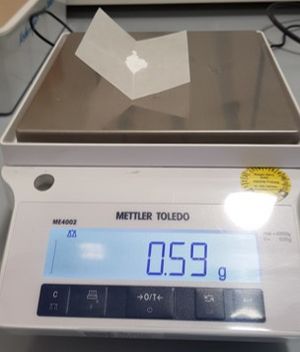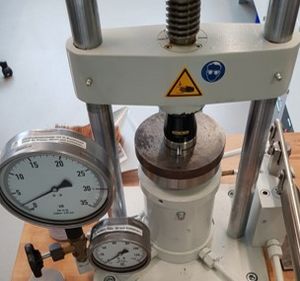Difference between revisions of "Pressing green bodies"
(→Selecting the right pressure) |
(→Selecting the right pressure) |
||
| Line 34: | Line 34: | ||
If, after pressing, the green body falls apart, this is usually more a sign of too high pressure than of too low pressure. A clear sign of too high presure is a lens-like fracture of the top or bottom surface of the the green body. | If, after pressing, the green body falls apart, this is usually more a sign of too high pressure than of too low pressure. A clear sign of too high presure is a lens-like fracture of the top or bottom surface of the the green body. | ||
| + | |||
| + | The pressing time is not very important, but should be selected such that the maximum pressure stops to drop while the press is not operated. | ||
== Pressing == | == Pressing == | ||
== Measuring the green density == | == Measuring the green density == | ||
== Do I need Cold Isostatic pressing? == | == Do I need Cold Isostatic pressing? == | ||
Revision as of 18:28, 1 July 2021
Pressing green bodies is an essential step of ceramic processing. As powder is being handled, make sure to wear PPE and use a hood whereever possible.
Contents
Powder properties for good pressing
Pressing green bodies does not work equally well for all ceramic powders. Very coarse powders tend not to give a mechanically stable green body, and very fine powders are difficult to handle due to their low tapping density. Powders with a particle size of 0.5-3µm are generally easiest to press into green bodies. It might be required to add a binder to assure a good mechanical stability of the green body. In this case, remember to remove the binder before sintering by a thermal treatment at 600-800°C in oxidizing atmosphere.
Quantity of powder
To obtain a given size of the green body after pressing, the amount of powder needs to be approximated. This requires knowledge of the green density and the density of the material itself.
Calculate the Volume of the required green body. Multiply with the green density and the density of the ceramic material itself. the result is the amount of powder required for pressing the green body.
Filling the Die
First, the die should be cleaned carefully to prevent contaminations and to assure that no powder particles are squeezed between the die and punches.
The lower punch is put into the die. The desired amount of powder is weighted on paper and filled into the die. Make sure to evenly distribute the powder within the die, e.g. by shaking. Insert upper punch. Put the die into the press. Remember to hold the lower punch.
Selecting the right pressure
An important parameter of pressing green bodies is the pressure. Its selection depents on many aspects:
1.) No Cold Isostatic Pressing (CIP) will be used after axial pressing. In this case, the final green density is only governed by the axial pressing step. Here, high pressures should be selected to assure a good green density.
2.) Cold Isostatic Pressing (CIP) will be used after axial pressing. Then, the axial pressing is only needed for shaping and the final green density will be reached during CIP. In this case, the lowest possible pressure should be chosen.
3.) The powder particle size: fine powders (e.g. D50 < 500nm) require higher pressures than coarse powders. The coarser the powder, the lower the pressure.
If, after pressing, the green body falls apart, this is usually more a sign of too high pressure than of too low pressure. A clear sign of too high presure is a lens-like fracture of the top or bottom surface of the the green body.
The pressing time is not very important, but should be selected such that the maximum pressure stops to drop while the press is not operated.




